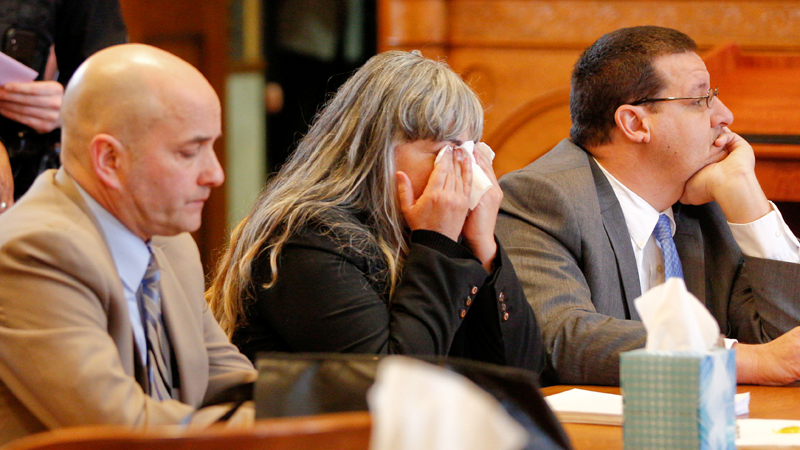Hoerig juror: ‘She meant to do it. She’s guilty’

SEE ALSO: Federal judge limits documents Hoerig can file in federal court
By ED RUNYAN
runyan@vindy.com
WARREN
After a jury decided to convict Claudia Hoerig of aggravated murder, the next decision is her punishment.
A jury took just three hours of deliberation Thursday to find her guilty in the March 12, 2007, shooting death of her husband, Maj. Karl Hoerig.
Claudia, 54, will learn her sentence at 10 a.m. Feb. 8.
Under Ohio law, Judge Andrew Logan of Trumbull County Common Pleas Court could sentence Claudia to life in prison without any chance of parole or life in prison with parole eligibility after 20, 25 or 30 years.
Claudia’s emotions seemed raw Thursday as she waited to hear the verdict in her case after a nearly two-week trial.
She wept at various times before the verdict and after.
The verdict included a specification her crime was committed with a gun, which adds three years to her sentence.
After the verdict, Ed and Paul Hoerig, father and brother of Karl Hoerig, stood silent as deputies removed Claudia from the courtroom.
The first sign of relief from those seeking punishment for Claudia came when Dennis Watkins, county prosecutor, approached Ed Hoerig and hugged him.
Watkins said later he was “extremely pleased” with the verdict, calling it part of a “long journey.”
One of the 12 jurors, Stephen Bistarkey, 19, of Niles, told reporters the jurors were in agreement on the verdict even though they considered the possibility she had justification for shooting him if her allegations about him were true.
“We get it. Mental abuse can take a toll on a person, but you should never kill someone. Get a divorce. There is no reason to kill him,” Bistarkey said.
He said the forensic evidence showing Claudia shot Karl in the head “really clarified everything.” Bistarkey said he felt if someone shot another person once out of rage, they would stop.
“But no. She shot him twice, went downstairs, went to his head and shot him again,” he said. “She meant to do it. She’s guilty.”
Bistarkey said Claudia showed no emotion when she talked about killing her husband and when she looked at photos of him, “She seemed like she didn’t even care really.”
Bistarkey also referred to a letter the jurors were given that was not read aloud during the trial. Claudia wrote it to Karl and some of his family members a short time before the murder. It talked about problems in their relationship.
“In the letter, it seemed like he wanted to leave more than she did. And that’s what I believe: He wanted to leave and she didn’t want that to happen.
“And she even said she married him because she was 40 and she thought she would be alone the rest of her life,” Bistarkey said. “And then she found Karl, didn’t want him to leave, and [he] was leaving her, so she killed him.”
U.S. Rep. Tim Ryan, D-13th of Howland, sponsored legislation and took other steps to get the Brazilian government to return Claudia to the United States.
“I am pleased that justice has been served in this monumental case,” Ryan said. “I want to thank Trumbull County Prosecutor Dennis Watkins and his team for their unwavering commitment and dedication to this case.”
He also thanked former U.S. Rep. John Boccieri for his efforts in the case over the past decade. Ryan offered “a big thank you to the Hoerig family and support team for their cooperation and patience while we navigated a long and convoluted process to get Claudia extradited.”
Ryan said he hopes the verdict “delivers some sense of closure and justice to the Hoerig family.”
Claudia admitted killing her husband, but she maintained she did not plan to do so. Premeditation was a requirement for her to be found guilty of aggravated murder.
The jurors were advised in jury instructions they could consider two lesser charges if they did not unanimously agree she was guilty of aggravated murder. One was murder, which carries a penalty of 15 years to life in prison. Another was voluntary manslaughter, which carries a penalty of about 10 years in prison.
Aggravated murder required the jury to find that Claudia acted purposely to kill Karl and acted with “prior calculation and design,” meaning the decision to kill “was reached by a definite process of reasoning in advance of the homicide.”
Murder is for a killing in which a person purposely causes the death of another but not with prior calculation and design.
Voluntary manslaughter means the person “acted knowingly while under the influence of sudden passion or in a sudden fit of rage, either of which was brought on by serious provocation occasioned by [the victim] that was reasonably sufficient to incite the defendant into using deadly force.”
Claudia’s native country of Brazil allowed her to be returned to the United States on Jan. 17, 2018, to face trial in a history-making Brazilian supreme court case.
She fled to Brazil the day she killed her husband, a pilot in the U.S. Air Force who flew nearly 200 combat missions in Iraq and Afghanistan and also worked as a commercial pilot.
Her country’s policies on extradition allowed her to live there freely until the country stripped her of her Brazilian citizenship and jailed her.
Brazilian news accounts have suggested U.S. officials agreed to limit her sentence in exchange for allowing her to be brought back to the United States. Watkins has said he won’t talk about such issues until after her sentencing.
The only thing Claudia has said about it in her many writings to state and federal courts and during a police interview is that the penalty in Brazil for murder is 18 to 30 years in prison.
 43
43
